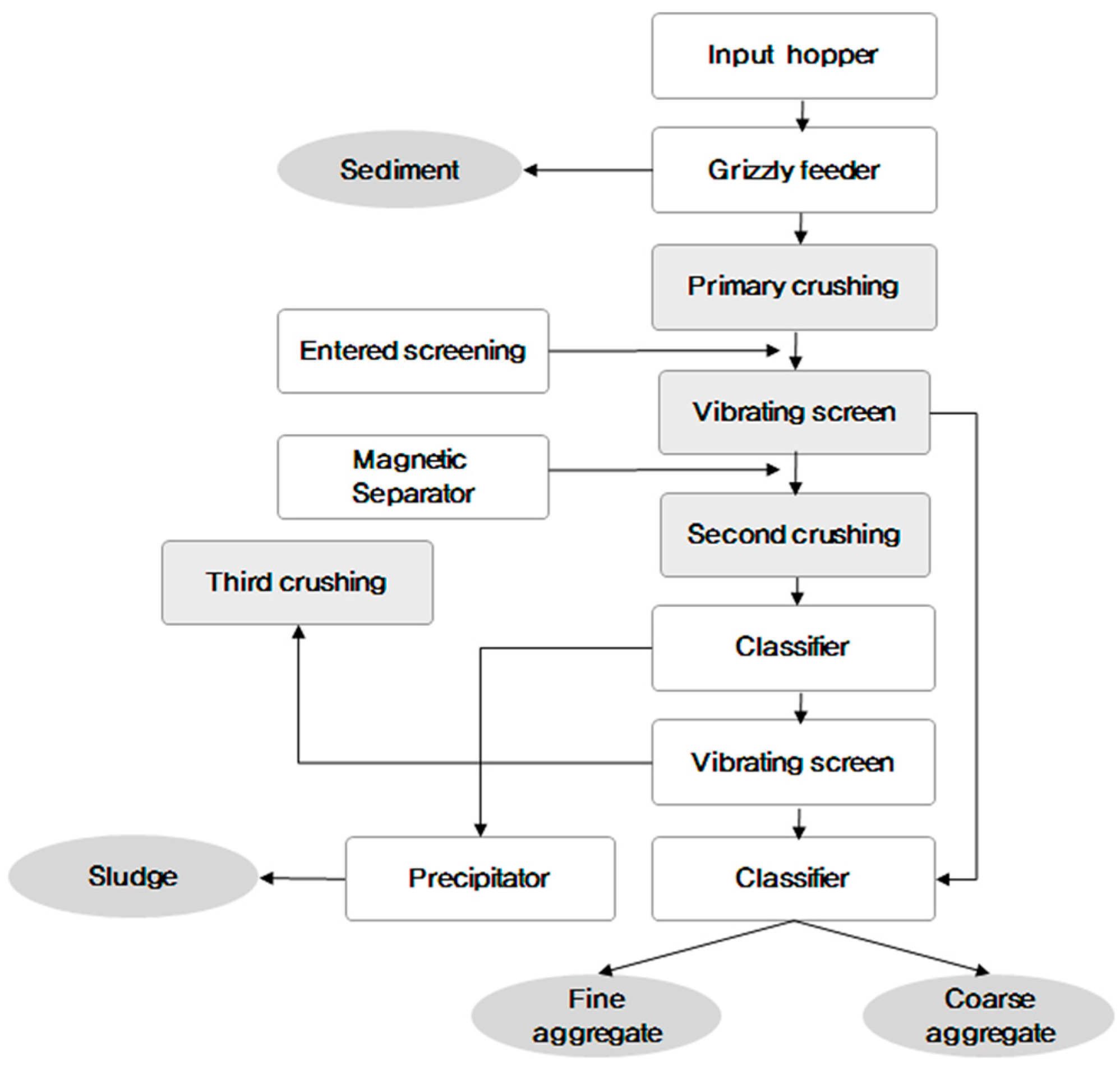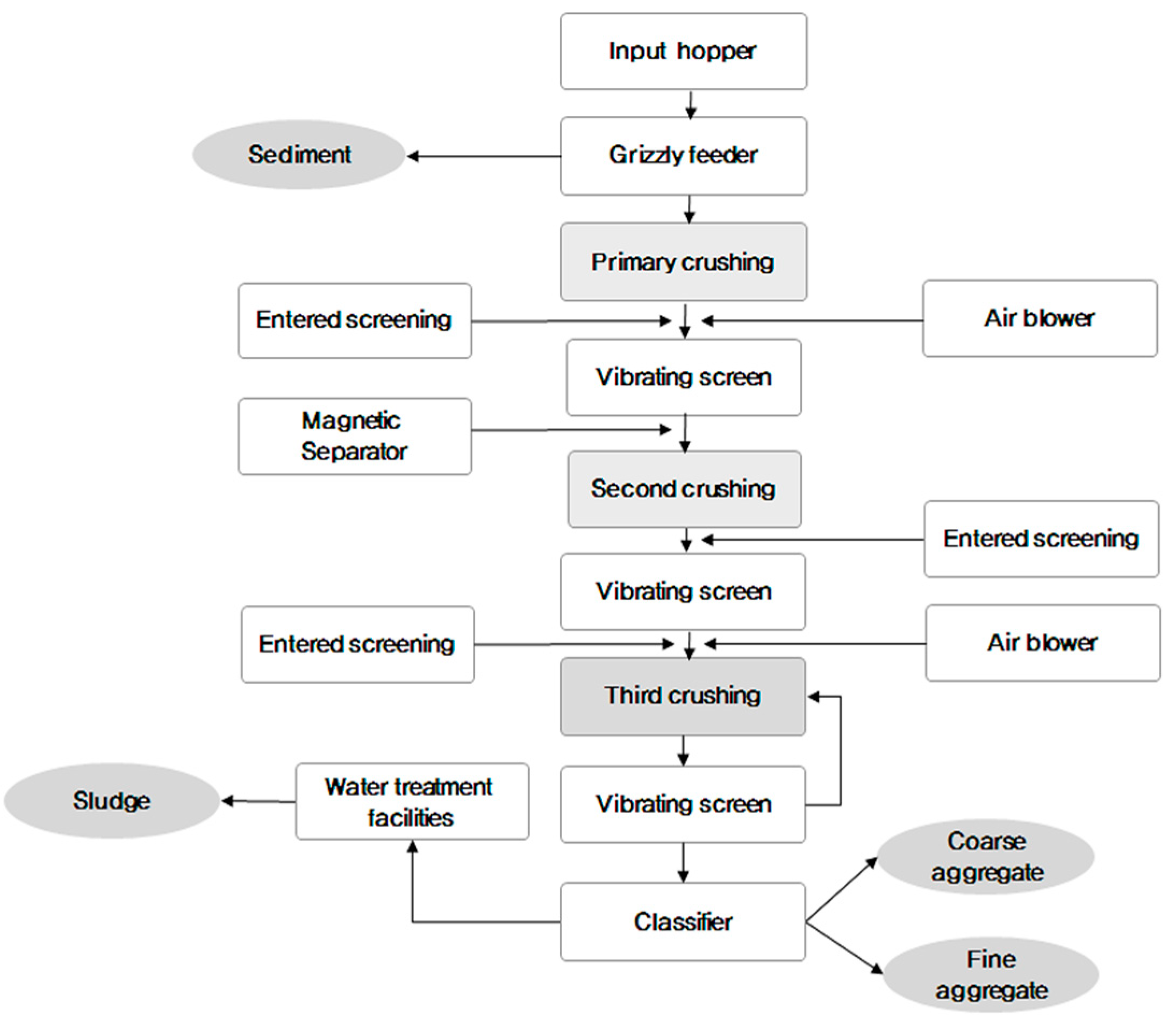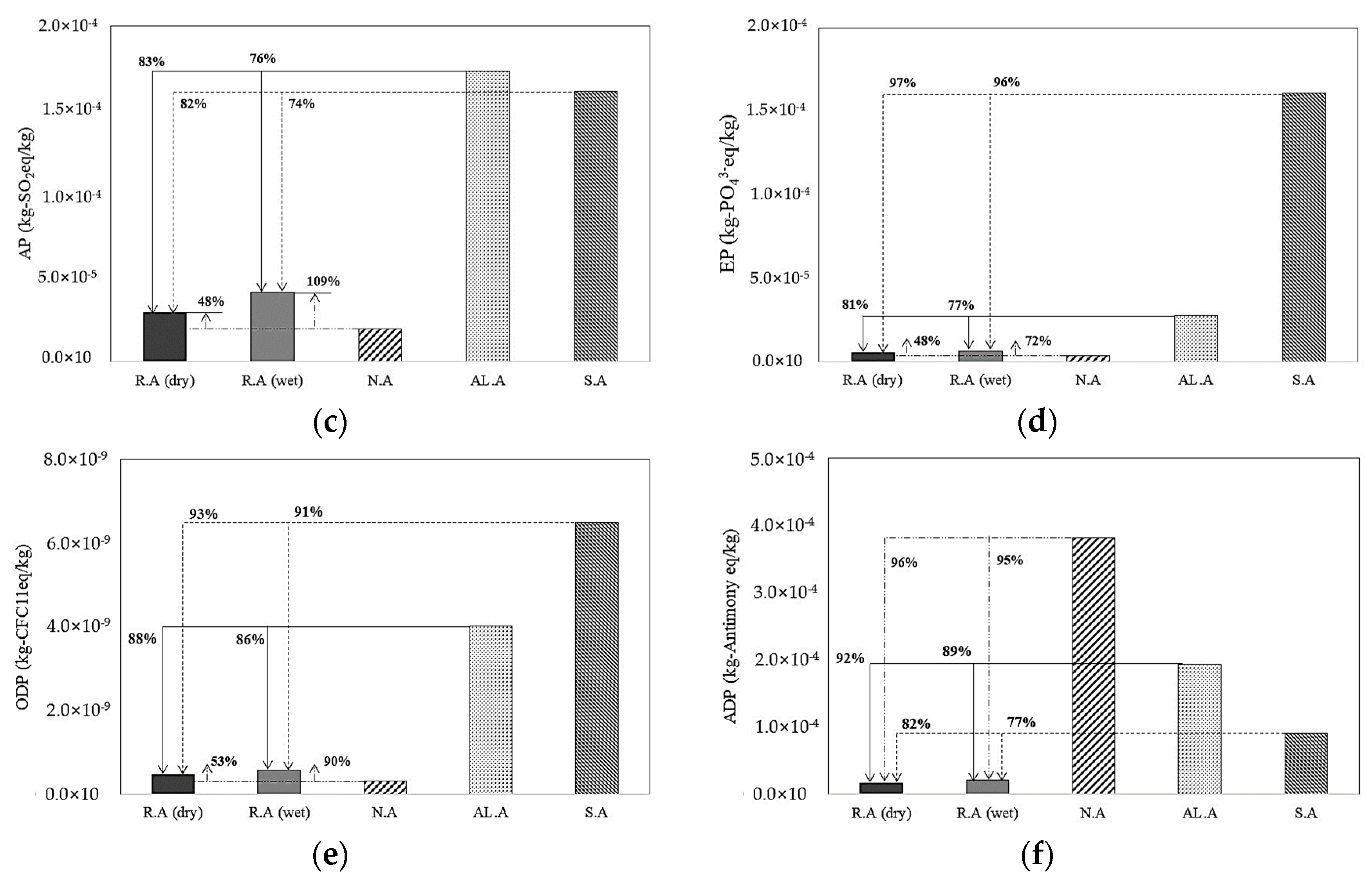Analysis of Life Cycle Environmental Impact of Recycled Aggregate
Abstract
1. Introduction
2. Literature Review
3. Analysis of Life Cycle Impact Assessment (LCIA)
3.1. Method
3.2. Process of LCIA
3.2.1. Raw Material Stage
3.2.2. Transportation Stage
3.2.3. Manufacturing Stage
Dry Method
Wet Method
3.3. Result of LCIA
4. Comparison of Life Cycle Impact Assessment
4.1. Method
4.2. Information on Other Aggregates
4.2.1. Natural Aggregate
4.2.2. Artificial Light-Weight Aggregate
4.2.3. Slag Aggregate
4.3. Comparison of Environmental Impact by Aggregate Type
5. Discussion
6. Conclusions
Author Contributions
Funding
Conflicts of Interest
References
- Ministry of the Interior. Law of Low-Carbon on Green Growth; Ministry of Government Legislation: Sejong-si, Korea, 2013.
- Department of Climate Policy. Climate Change Handbook, Korea Meteorological Administration; Korea Meteorological Administration: Seoul, Korea, 2009.
- Ministry of Environment. Waste Recycling: Extended Producer Responsibility; Ministry of Environment: Sejong-si, Korea, 2012.
- Butera, S.; Christensen, T.H.; Astrup, T.F. Life cycle assessment of construction and demolition waste management. Waste Manag. 2015, 44, 196–205. [Google Scholar] [CrossRef] [PubMed]
- Rosado, L.P.; Vitale Penteado, C.S.G.; Arena, U. Life cycle assessment of natural and mixed recycled aggregate production in Brazil. J. Clean. Prod. 2017, 151, 634–642. [Google Scholar] [CrossRef]
- Tam, V.W.Y.; Soomro, M.; Evangelista, A.C.J. A review of recycled aggregate in concrete applications (2000–2017). Constr. Build. Mater. 2018, 172, 272–292. [Google Scholar] [CrossRef]
- Hossain, M.U.; Poon, C.S.; Lo, I.M.C.; Cheng, J.C.P. Comparative environmental evaluation of aggregate production from recycled waste materials and virgin sources by LCA. Resour. Conserv. Recycl. 2016, 109, 67–77. [Google Scholar] [CrossRef]
- Yazdanbakhsh, A.; Lagouin, M. The effect of geographic boundaries on the results of a regional life cycle assessment of using recycled aggregate in concrete. Resour. Conserv. Recycl. 2019, 143, 201–209. [Google Scholar] [CrossRef]
- Ghisellini, P.; Ripa, M.; Ulgiati, S. Exploring environmental and economic costs and benefits of a circular economy approach to the construction and demolition sector. J. Clean. Prod. 2018, 178, 618–643. [Google Scholar] [CrossRef]
- Julliena, A.; Proust, C.; Martaud, T.; Rayssac, E.; Ropert, C. Variability in the environmental impacts of aggregate production. Resour. Conserv. Recycl. 2012, 62, 1–13. [Google Scholar] [CrossRef]
- Kurda, R.; Silvestre, J.D.; de Brito, J. Life cycle assessment of concrete made with high volume of recycled concrete aggregates and fly ash. Resour. Conserv. Recycl. 2018, 139, 407–417. [Google Scholar] [CrossRef]
- Wijayasundara, M.; Mendis, P.; Zhang, L.; Sofi, M. Financial assessment of manufacturing recycled aggregate concrete in ready-mix concrete plants. Resour. Conserv. Recycl. 2016, 109, 187–201. [Google Scholar] [CrossRef]
- Marinkovic, S.; Radonjanin, V.; Malešev, M.; Ignjatovic, I. Comparative environmental assessment of natural and recycled aggregate concrete. Waste Manag. 2010, 30, 2255–2264. [Google Scholar] [CrossRef]
- Kurda, R.; de Brito, J.; Silvestre, J.D. Carbonation of concrete made with high amount of fly ash and recycled concrete aggregates for utilization of CO2. J. CO2 Util. 2019, 29, 12–19. [Google Scholar] [CrossRef]
- Colangelo, F.; Petrillo, A.; Cioffi, R.; Borrelli, C.; Forcina, A. Life cycle assessment of recycled concretes: A case study in southern Italy. Sci. Total Environ. 2018, 615, 1506–1517. [Google Scholar] [CrossRef] [PubMed]
- Hossain, M.U.; Poon, C.S.; Dong, Y.H.; Lo, I.M.C.; Cheng, J.C.P. Development of social sustainability assessment method and a comparative case study on assessing recycled construction materials. Int. J. Life Cycle Assess. 2018, 23, 1654–1674. [Google Scholar] [CrossRef]
- Marinković, S.B.; Ignjatović, I.; Radonjanin, V. Handbook of Recycled Concrete and Demolition Waste (Life-Cycle Assessment of Concrete with Recycled Aggregates); Woodhead Publishing Series in Civil and Structural Engineering; Woodhead Publishing: Cambridge, UK, 2013; pp. 569–604. [Google Scholar]
- Rodríguez-Robles, D.; Van Den Heede, P.; De Belie, N. New Trends in Eco-Efficient and Recycled Concrete (Life Cycle Assessment Applied to Recycled Aggregate Concrete); Woodhead Publishing Series in Civil and Structural Engineering; Woodhead Publishing: Cambridge, UK, 2019; pp. 207–256. [Google Scholar]
- Tošić, N.; Marinković, S.; Dašić, T.; Stanić, M. Multicriteria optimization of natural and recycled aggregate concrete for structural use. J. Clean. Prod. 2015, 87, 766–776. [Google Scholar] [CrossRef]
- Wijayasundara, M.; Crawford, R.H.; Mendis, P. Comparative assessment of embodied energy of recycled aggregate concrete. J. Clean. Prod. 2017, 152, 406–419. [Google Scholar] [CrossRef]
- Cuenca-Moyano, G.M.; Zanni, S.; Bonoli, A.; Valverde-Palacios, I. Development of the life cycle inventory of masonry mortar made of natural and recycled aggregates. J. Clean. Prod. 2017, 140, 1272–1286. [Google Scholar] [CrossRef]
- Taehyoung, K.; Sungho, T.; Seongjun, R. Assessment of the CO2 emission and cost reduction performance of a low-carbon-emission concrete mix design using an optimal mix design system. Renew. Sustain. Energy Rev. 2013, 25, 729–741. [Google Scholar]
- Serres, N.; Braymand, S.; Feugeas, F. Environmental evaluation of concrete made from recycled concrete aggregate implementing life cycle assessment. J. Build. Eng. 2016, 5, 24–33. [Google Scholar] [CrossRef]
- Shan, X.; Zhou, J.; Chang, V.; Yang, E.-H. Life cycle assessment of adoption of local recycled aggregates and green concrete in Singapore perspective. J. Clean. Prod. 2017, 164, 918–926. [Google Scholar] [CrossRef]
- Colangelo, F.; Cioff, R. Mechanical properties and durability of mortar containing fine fraction of demolition wastes produced by selective demolition in South Italy. Compos. Part B 2017, 115, 43–50. [Google Scholar] [CrossRef]
- Kim, T.H.; Tae, S.H. Proposal of Environmental Impact Assessment Method for Concrete in South Korea: An Application in LCA (Life Cycle Assessment). Int. J. Environ. Res. Public Health 2016, 13, 1074. [Google Scholar] [CrossRef] [PubMed]
- Kim, T.H.; Tae, S.H.; Suk, S.J.; George, F.; Yang, K.H. An Optimization System for Concrete Life Cycle Cost and Related CO2 Emissions. Sustainability 2016, 8, 361. [Google Scholar] [CrossRef]
- Ministry of Land, Transport and Maritime Affairs of the Korean government. National D/B for Environmental Information of Building Products; Ministry of Land, Transport and Maritime Affairs of the Korean Government: Sejong, Korea, 2008.
- Korea Environmental Industry and Technology Institute. National Life Cycle Index Database Information Network. Available online: http://www.edp.or.kr (accessed on 31 October 2018).
- IPCC Guidelines for National Greenhouse Gas Inventories. Available online: http://www.ipccnggip.iges.or.jp/public/2006gl/ (accessed on 31 October 2018).
- Guinee, J.B. Development of a Methodology for the Environmental Life Cycle Assessment of Products: with a Case Study on Margarines. Ph.D. Thesis, Leiden University, Leiden, The Netherlands, 1995. [Google Scholar]
- Heijungs, R.; Guinée, J.B.; Huppes, G.; Lamkreijer, R.M.; Udo de Haes, H.A.; Wegener Sleeswijk, A.; Ansems, A.M.M.; Eggels, P.G.; van Duin, R.; de Goede, H.P. Environmental Life Cycle Assessment of Products. Guide (Part1) and Background (Part 2); CML Leiden University: Leiden, The Netherlands, 1992. [Google Scholar]
- World Metrological Organization (WMO). Scientific Assessment of Ozone Depletion: Global Ozone Research and Monitoring Project; WHO: Geneva, Switzerland, 1991; p. 25. [Google Scholar]
- Derwent, R.G.; Jenkin, M.E.; Saunders, S.M.; Piling, M.J. Photochemical ozone creation potentials for organic compounds in Northwest Europe calculated with a master chemical mechanism. Atmos. Environ. 1998, 32, 2429–2441. [Google Scholar] [CrossRef]
- Jenkin, M.; Hayman, G. Photochemical Ozone Creation Potentials for oxygenated volatile organic compounds: Sensitivity to variation is in kinetic and mechanistic parameters. Atmos. Environ. 1999, 33, 1275–1293. [Google Scholar] [CrossRef]
- Jung, J.S.; Lee, J.S.; An, Y.J.; Lee, K.H.; Bae, K.S.; Jun, M.H. Analysis of Emission of Carbon Dioxide from Recycling of Waste Concrete. Archit. Inst. Korea 2008, 24, 109–116. [Google Scholar]
- Kim, T.H.; Tae, S.H.; Chae, C.U.; Choi, W.Y. The Environmental Impact and Cost Analysis of Concrete Mixing Blast Furnace Slag Containing Titanium Gypsum and Sludge in South Korea. Sustainability 2016, 8, 502. [Google Scholar] [CrossRef]
- Lee, D.H.; Jun, M.H.; Bae, K.S. Correlation between density and absorption of domestic recycled aggregate. Korean Recycl. Constr. Res. Inst. 2011, 11, 95–96. [Google Scholar]
- Kim, T.H.; Tae, S.H.; Chae, C.U. Analysis of Environmental Impact for Concrete Using LCA by Varying the Recycling Components, the Compressive Strength and the Admixture. Sustainability 2016, 8, 389. [Google Scholar] [CrossRef]





| Division | Reference | Country | |
|---|---|---|---|
| Raw material | Waste concrete | National LCI | Korea |
| Energy | Electric | National LCI | Korea |
| Diesel | National LCI | Korea | |
| Kerosene | National LCI | Korea | |
| Transportation | Truck | National LCI | Korea |
| Dry System | Operation Count | Total Electricity Usage | |
|---|---|---|---|
| Feeders | Grizzly feeder | 1 time | 183.33 kW |
| Screen | Vibrating screen | 4 times | 169.01 kW |
| Crusher | Jaw Crusher | 1 time | 593.75 kW |
| Cone Crusher | 3 times | 529.41 kW | |
| Magnetic Separator | 1 time | 250.00 kW | |
| Classifier | 3 times | 289.47 kW | |
| Precipitator | 1 time | 750.00 kW | |
| Dry System | Operation Count | Total Electricity Usage | |
|---|---|---|---|
| Feeders | Grizzly feeder | 1 time | 315.79 kW |
| Screen | Vibrating screen | 3 times | 240.00 kW |
| Crusher | Jaw crusher | 1 time | 600.00 kW |
| Cone crusher | 1 time | 450.00 kW | |
| Impact crusher | 1 time | 950.00 kW | |
| Air blower | 2 times | 840.00 kW | |
| Magnetic Separator | 3 times | 120.00 kW | |
| Classifier | 1 time | 1050.00 kW | |
| Division | GWP (kg-CO2eq/kg) | AP (kg-SO2eq/kg) | EP (kg-PO43−eq/kg) | ODP (kg-CFC11eq/kg) | POCP (kg-C2H4 eq/kg) | ADP (kg-Antimonyeq/kg) | |
|---|---|---|---|---|---|---|---|
| Raw material stage | 3.10 × 10−3 | 3.90 × 10−6 | 7.90 × 10−7 | 3.00 × 10−11 | 8.30 × 10−6 | 1.00 × 10−6 | |
| Transportation stage | 4.00 × 10-3 | 7.50 × 10−6 | 1.08 × 10−6 | 7.00 × 10−11 | 1.10 × 10−6 | 1.30 × 10−5 | |
| Manufacture stage | Dry | 2.23 × 10−2 | 1.79 × 10−5 | 3.57 × 10−6 | 3.70 × 10−10 | 3.10 × 10−6 | 2.00 × 10−6 |
| Wet | 3.10 × 10−2 | 2.99 × 10−5 | 4.46 × 10−6 | 4.80 × 10−10 | 5.90 × 10−6 | 7.00 × 10−6 | |
| TOTAL | Dry | 2.94 × 10−2 | 2.93 × 10−5 | 5.44 × 10−6 | 4.70 × 10−10 | 1.25 × 10−5 | 1.60 × 10−5 |
| Wet | 3.81 × 10−2 | 4.13 × 10−5 | 6.33 × 10−6 | 5.80 × 10−10 | 1.53 × 10−5 | 2.10 × 10−5 | |
| Division | GWP (kg-CO2eq/m3) | AP (kg-SO2eq/m3) | EP (kg-PO43−eq/m3) | ODP (kg-CFC11eq/m3) | POCP (kg-C2H4eq/m3) | ADP (kg-Antimonyeq/m3) | |
|---|---|---|---|---|---|---|---|
| Recycled aggregate | Dry | 2.94 × 10−2 | 2.93 × 10−5 | 5.44 × 10−6 | 4.68 × 10−10 | 1.25 × 10−5 | 1.60 × 10−5 |
| Wet | 3.81 × 10−2 | 4.13 × 10−5 | 6.33 × 10−6 | 5.80 × 10−10 | 1.53 × 10−5 | 2.10 × 10−5 | |
| Artificial Lightweight aggregate | 5.16 × 10−2 | 1.73 × 10−4 | 2.80 × 10−5 | 4.01 × 10−9 | 5.28 × 10−5 | 1.94 × 10−4 | |
| Slag aggregate | 2.26 × 10−2 | 1.61 × 10−4 | 1.61 × 10−4 | 6.49 × 10−9 | 2.43 × 10−5 | 9.08 × 10−5 | |
| Natural aggregate (Gravel) | 1.43 × 10−2 | 1.98 × 10−5 | 3.67 × 10−6 | 3.06 × 10−10 | 1.41 × 10−5 | 3.82 × 10−4 | |
© 2019 by the authors. Licensee MDPI, Basel, Switzerland. This article is an open access article distributed under the terms and conditions of the Creative Commons Attribution (CC BY) license (http://creativecommons.org/licenses/by/4.0/).
Share and Cite
Park, W.-J.; Kim, T.; Roh, S.; Kim, R. Analysis of Life Cycle Environmental Impact of Recycled Aggregate. Appl. Sci. 2019, 9, 1021. https://doi.org/10.3390/app9051021
Park W-J, Kim T, Roh S, Kim R. Analysis of Life Cycle Environmental Impact of Recycled Aggregate. Applied Sciences. 2019; 9(5):1021. https://doi.org/10.3390/app9051021
Chicago/Turabian StylePark, Won-Jun, Taehyoung Kim, Seungjun Roh, and Rakhyun Kim. 2019. "Analysis of Life Cycle Environmental Impact of Recycled Aggregate" Applied Sciences 9, no. 5: 1021. https://doi.org/10.3390/app9051021
APA StylePark, W.-J., Kim, T., Roh, S., & Kim, R. (2019). Analysis of Life Cycle Environmental Impact of Recycled Aggregate. Applied Sciences, 9(5), 1021. https://doi.org/10.3390/app9051021







